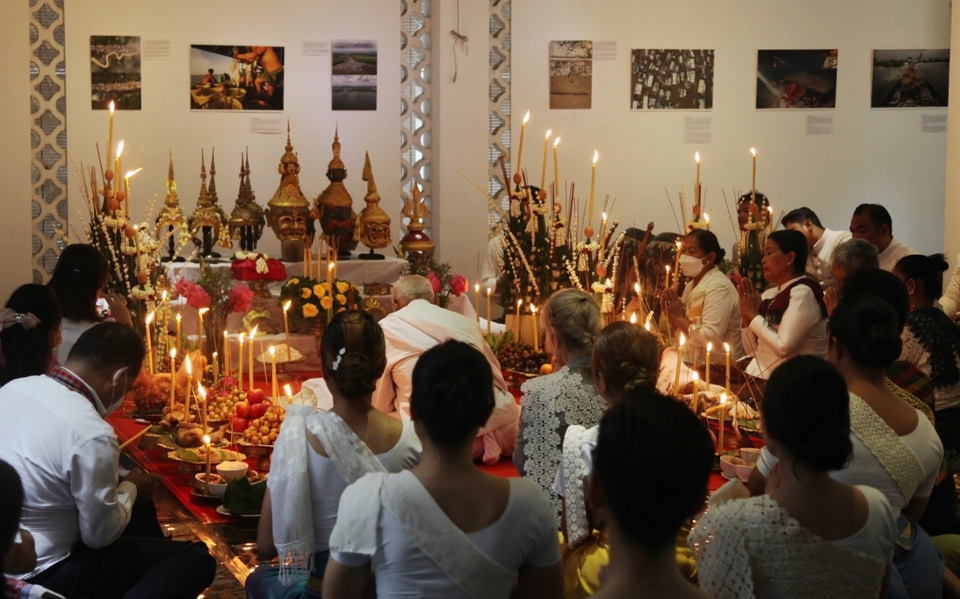A Newly Digitized Archival Collection Documents Post-Genocide Cambodian Dance Practice

Photo Credit: Photo by Choulay Mech
By Toni Shapiro-Phim, Co-Director,
Program in Peacebuilding and the Arts, Brandeis University
Hundreds of hours of videotape that I took three decades ago have recently been digitized, and placed in a public archive so that Cambodian dancers and, indeed, anyone interested in the footage, can access it. I received a grant in 2021 to have the videotapes that I shot while undertaking dissertation research, both in Site 2 Cambodian refugee camp in Thailand (on the border with Cambodia) and inside Cambodia in the early 1990s, digitized. In May of 2022 I traveled to Cambodia to place a hard drive with the digital files at the Bophana Audiovisual Resource Center in Phnom Penh, the country’s capital.
In the early 1990s Cambodia was still reeling from a genocide that had ended in 1979. Damage, disruption, and displacement were acute: nearly everyone in the country had experienced the death of loved ones, and the loss of livelihoods and homes, if not entire families or communities, during the years of Khmer Rouge rule (1975-1979). Between a quarter and a third of the population, including an estimated 80% or more of the nation’s professional dancers, had perished from starvation, disease, overwork and murder. Dancers had been among those who, immediately after liberation from the tyrannical Khmer Rouge, worked to bring the country out of the collective nightmare through the re-creation of beloved aspects of Cambodia’s cultural heritage, including rituals that nurture the well-being of the land and its people, even while hardship continued. When Vietnam defeated the Khmer Rouge in 1979 and remained in Cambodia, sharing political power with Cambodians who had defected from the ousted genocidal regime, the U.S. spearheaded an international embargo, isolating Cambodia from much-needed aid. (Vietnam and the United States were enemies at the time.) It was in this context that I first arrived in Cambodia, in April 1990, after having spent months in Site 2 displaced persons camp, where close to 150,000 Cambodians had been living for years.
Site 2, even though it was inside Thailand, was in a war zone. The Vietnamese-backed government in Phnom Penh was engaged in battle with the military arms of previous Cambodian regimes, including the Khmer Rouge, all of whom wanted to regain power, and all of whom had regrouped along the Thai-Cambodian border. In the camp, the United Nations and non-governmental organizations established health, education, and sanitation programs, while the Cambodians themselves, living in constant danger and with complete uncertainty about their future, set up performing arts centers. When I met with directors of those centers, they selected Cambodia’s classical dance as the first art form they’d like to document, and I worked with them on that effort. I filmed training, rehearsals, ceremonies and performances as well as some aspects of daily life, and interviews. When I moved into Cambodia to continue my research, I left copies of the videotapes with the camp’s artists. But a fire in Site 2 destroyed all our documentation. Fortunately, I had the original tapes with me.
Once in Cambodia I witnessed the same drive I had seen among dancers in the camp – a hunger to bring back as much of the repertoire of dances and dance-dramas as possible, to offer these stories with moral potency to their compatriots. From the very first day I was in Phnom Penh, people helped guide my research, and my documentation: they told me what and who was important to them, and to the art form. I stayed in Cambodia for over two years. Since then, I’ve been lucky to be able to return many times, including for another extended stay of a couple of years from 2008 to 2010.
Finally, I was able to get my hours of videotape digitized – videotapes of genocide survivors trying to help each other remember specific gestures and choreography after the almost four years when classical dance had been forbidden; of dance teachers molding their students in a class or at the teacher’s home; of dancers and musicians offering prayers to the spirits of the arts through melody and movement; of performances on makeshift stages or in theaters or in the Royal Palace. This year, artists in Cambodia, including a number who were in Site 2 when I was there and who repatriated to Cambodia when the camp closed, watched clips from this digitized collection, and, after reacting emotionally to this captured history, shared ideas of ways to use the footage. Some proposed showing selected scenes to current dance students as lessons about the development of their art, and as inspiration for new choreography; others are interested in making films about specific teachers or particular dances; many want to share the material with their children, so “they know what we lived through.”
One of the highlights of my May visit to Cambodia was the sampeah kru ceremony, a ritual through which dancers and musicians venerate teachers and spirits of these arts. Artists asked for blessings for the digitized material, sought guidance in its use, and promised to continue to honor the spirits (and all teachers), as they keep these traditions dynamic. The 10-terabyte hard drive, wrapped in red silk and covered with a garland of jasmine flowers, was on the altar, along with crowns, masks and other dance accoutrements. Rows of offerings – fruits and sweets, among other things, topped with incense and candles – stretched forward from the altar. About 200 people participated, including dancers of many generations. There were people I had first met (and filmed) when they were 10-year-old budding artists, along with others just now in their 20s, as well as those who had been dancers long before the genocide. Some, in their 80s, with trouble standing and walking, were nonetheless moved to rise – with help from those nearby – and dance as part of the ceremony, reinforcing their spiritual and kinesthetic connection and commitment to their heritage, and its future.